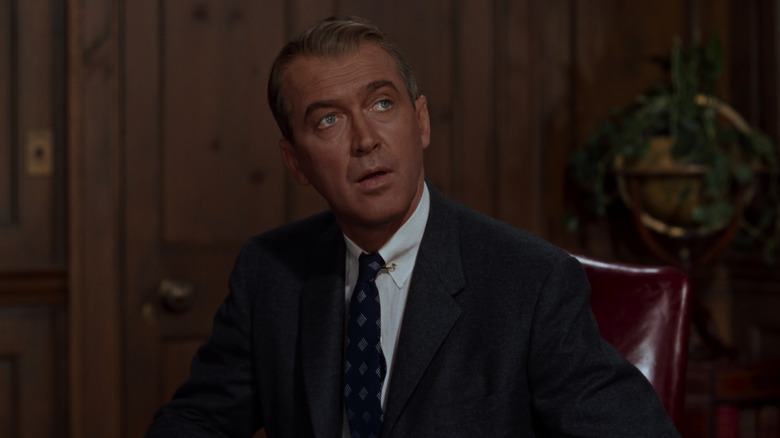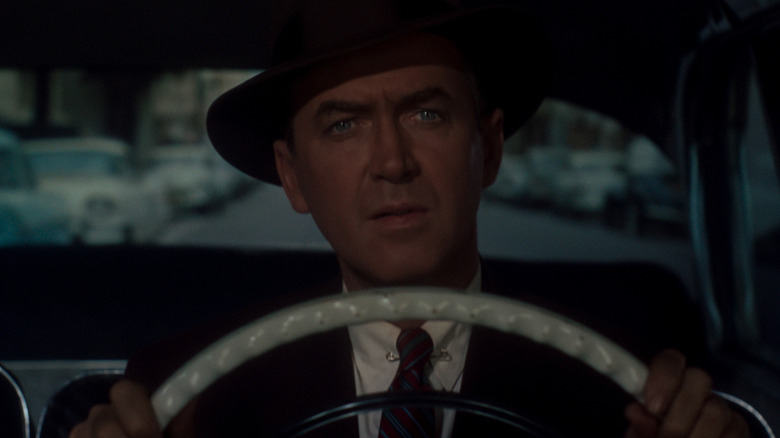The Classic Cary Grant Role Jimmy Stewart Was Begging To Play
Jimmy Stewart and Cary Grant each starred in four Alfred Hitchcock films. They worked with the director an equal number of times, with Stewart appearing in "Rope," "Rear Window," "The Man Who Knew Too Much," and "Vertigo," and Grant appearing in "They Are Suspicion," "Notorious," "To Catch a Thief," and "North by Northwest." Stewart's collaborations were spread out from 1948 to 1958, while Grant's encompassed almost all of two decades, from 1941 to 1959.
Unlike, for instance, Martin Scorsese, who has had one main go-to leading man at any given time (first, Robert De Niro, then, later, Leonardo DiCaprio), the prolific Hitchcock traded off between the two stars and other earlier marquee names. After "Vertigo," their final film together, Stewart was eager to continue working with Hitchcock, and in fact, he wanted to play the part that eventually went to Grant in "North by Northwest." Hitchcock had (via IMDb) piqued Stewart's interest by describing the plot of his next film to him while they were still in production on "Vertigo."
As Turner Classic Movies (TCM) notes, Stewart "lobbied hard for the lead role in 'North By Northwest,' but Hitchcock, while he admired his friend and frequent lead actor, did not envision Stewart as the dashing Roger Thornhill." Given that they had enjoyed such a long and fruitful working relationship, it was not easy for Hitchcock to tell Stewart that he had another star in mind for "North by Northwest." So, it would seem he avoided telling him altogether and instead just played a waiting game.
How Hitchcock Spared Stewart's Feelings
According to TCM, "Hitchcock was able to stall Stewart long enough until the actor was forced to start work on 'Bell, Book and Candle' for Columbia Pictures." That film came out in November 1958, about six months after "Vertigo" had hit theaters. It gave Hitchcock a good excuse to go forward with Grant, or at least get the ball rolling on that. Express and IMDb both indicate that Hitchcock also scheduled the production of "North by Northwest" so it would overlap with Stewart's next film, the 1959 Otto Preminger courtroom drama, "Anatomy of a Murder."
Once Stewart was entrenched in these other projects, Hitchcock could safely extend a formal offer to him for the lead in "North by Northwest," knowing that the actor would not be able to accept since he now had other prior commitments. Hitchcock went to great lengths not to hurt Stewart's feelings or damage their relationship, even though he reportedly felt that Stewart, at 50, had looked too old opposite the 25-year-old Kim Novak in "Vertigo."
That film, which some critics now regard as the greatest movie of all time, was not initially a commercial or critical success, which may have contributed to Hitchcock's reluctance to cast Stewart again so soon, especially since "North by Northwest" called for a romantic element. The irony is that "North by Northwest" is considered by some to be an early prototype for the James Bond films, which would follow soon after it in the 1960s. Yet Grant himself, who was on the cusp of retirement by then, lost out the part of Bond to a younger actor, Sean Connery.

